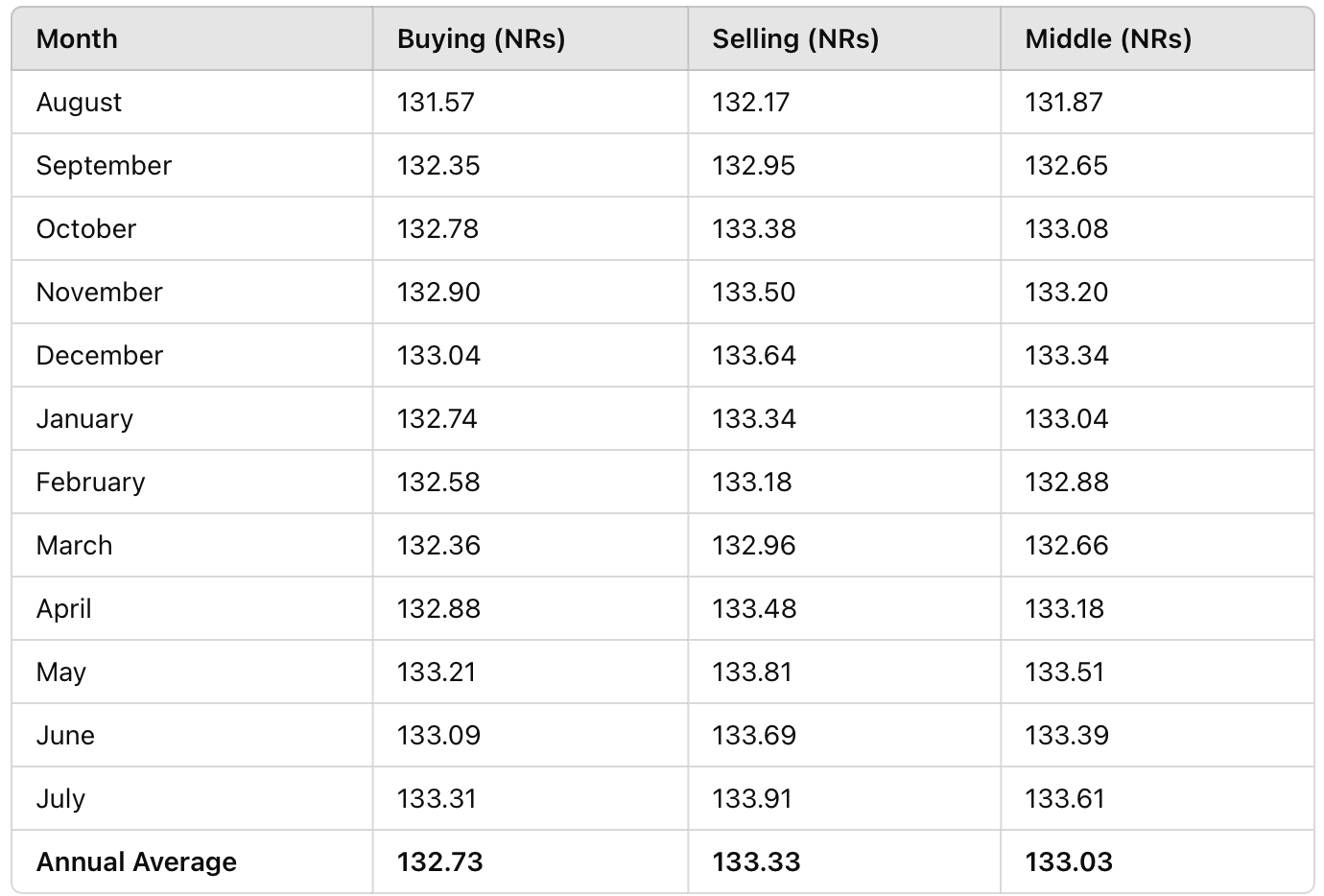US Dollar Exchange Rate Reaches New Highs: Impact on Nepal's Economy
Author
Dipesh Ghimire

athmandu, Nepal – The exchange rate of the US dollar has been steadily increasing, causing significant implications for Nepal’s economy. According to data published by Nepal Rastra Bank, the annual average exchange rate for 2023/24stood at NRs 132.73 (buying), NRs 133.33 (selling), and NRs 133.03 (middle rate).
However, with the beginning of the 2024/25 fiscal year, the exchange rate has been consistently rising, reaching NRs 136.42 (buying) and NRs 137.02 (selling) in January 2025. Financial analysts predict that the dollar could continue to appreciate in the coming months, potentially impacting multiple sectors in Nepal.
1. Recent US Dollar Exchange Rate Trends
Exchange Rate for 2023/24
The following table shows the monthly average exchange rates for 2023/24:

Exchange Rate for 2024/25

The data indicates that in the first six months of 2024/25, the exchange rate has been increasing steadily. In January 2025, the buying rate hit NRs 136.42, and the selling rate reached NRs 137.02, significantly higher than the annual average of 2023/24.
2. Reasons Behind the Rising US Dollar Exchange Rate
1. US Federal Reserve’s Interest Rate Policy
The US Federal Reserve has raised interest rates multiple times, making the US dollar stronger globally. This has directly influenced developing economies like Nepal, where the demand for dollars has surged.
2. Decline in Nepal’s Foreign Exchange Reserves
According to Nepal Rastra Bank, Nepal’s foreign exchange reserves have been depleting, leading to increased pressure on the Nepali rupee.
3. Trade Imbalance in Nepal
Nepal is an import-heavy economy. The country imports essential goods such as petroleum, vehicles, electronics, and medicines in US dollars. The increasing demand for dollars in the import sector has contributed to the rising exchange rate.
4. Global Economic Uncertainty
Several international factors have led to a rise in the US dollar’s value:
Russia-Ukraine war,
Middle East conflicts,
US-China trade tensions,
Rising inflation in global markets.
These factors have made the US dollar stronger against most currencies, including the Nepali rupee.
3. Impact of US Dollar Appreciation on Nepal’s Economy
1. Negative Effects
- Higher Import Costs
Since Nepal relies heavily on imports, the rising US dollar means that the cost of imported goods will increase. This includes:
Petroleum products,
Electronic devices (mobile phones, laptops, etc.),
Medicines and healthcare equipment,
Construction materials (cement, iron, etc.).
- Inflation and Increased Cost of Living
As imports become more expensive, the cost of goods and services will rise, leading to higher inflation in Nepal.
- Impact on Businesses
Businesses that rely on imported raw materials, such as manufacturing industries, automobile dealers, and the pharmaceutical sector, will face increased costs, potentially leading to higher product prices for consumers.
2. Positive Effects
- Increase in Remittance Inflows
Nepal receives billions of dollars in remittances annually from Nepali workers abroad. A stronger US dollar means that when Nepalis working overseas send money back home, their families will receive more Nepali rupees per dollar. This could partially offset inflationary pressures for households dependent on remittances.
- Growth in Export-Oriented Sectors
Businesses involved in exports—such as handicrafts, pashmina, tea, ginger, carpets, and textiles—will benefit from a weaker Nepali rupee, as their products become cheaper and more competitive in international markets.
4. Outlook for the Coming Months
Economic analysts predict that the US dollar exchange rate may continue to rise unless:
Nepal Rastra Bank takes strong measures to stabilize foreign exchange reserves.
The country increases exports and reduces import dependency.
Global economic conditions stabilize.
If the US dollar continues to appreciate, Nepal may face higher inflation, increased living costs, and economic slowdowns, while remittance receivers and exporters may benefit in the short run.
5. Conclusion
The continuous appreciation of the US dollar has created a mixed impact on Nepal’s economy. While importers, consumers, and businesses reliant on imports are feeling the pressure, remittance receivers and export-based businesses are benefiting.
To address these economic challenges, Nepal Rastra Bank must implement strategic monetary policies to:
Stabilize foreign reserves,
Promote local production,
Encourage exports,
Reduce unnecessary imports.
As global economic uncertainties continue, Nepal must adopt proactive financial policies to minimize the negative impact of a strong US dollar and safeguard long-term economic stability.



